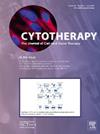依托泊苷 + 阿糖胞苷 + pegfilgrastim动员方案与单独G-CSF动员方案对多发性骨髓瘤和淋巴瘤患者造血干细胞动员的疗效和安全性。
IF 3.2
3区 医学
Q2 BIOTECHNOLOGY & APPLIED MICROBIOLOGY
引用次数: 0
摘要
背景:尽管在治疗多发性骨髓瘤和淋巴瘤方面取得了巨大进展,但大剂量化疗后的自体造血干细胞移植(ASCT)仍然是治疗的重要组成部分。动员足够数量的高质量外周血干细胞(PBSC)是影响ASCT成功的主要因素。然而,仍然需要进一步的研究来确定造血干细胞动员的最佳方法。研究设计和方法:这项回顾性的单中心研究旨在比较依托泊苷、阿糖胞苷和聚非格苷(EAP)联合治疗方案和粒细胞集落刺激因子(G-CSF)单独治疗方案对造血干细胞动员的疗效和安全性。结果:该队列包括52例分配到EAP动员方案的患者,62例接受G-CSF单药治疗。与G-CSF组相比,EAP组先前接受多线化疗(P=0.001)、放射治疗(P=0.018)和达拉单抗治疗(P=0.006)的比例更高。基线人口统计学参数显示组间无显著差异。结果表明,EAP在优化CD34+细胞产量方面表现出优越的疗效(p)。讨论:与G-CSF单药治疗相比,EAP方案在保持可接受的毒性谱的同时显着提高了动员效率。这些发现表明,EAP方案可能是多发性骨髓瘤或淋巴瘤患者动员造血干细胞的优越选择。本文章由计算机程序翻译,如有差异,请以英文原文为准。
Efficacy and safety of etoposide + cytarabine + pegfilgrastim mobilization regimen versus G-CSF mobilization regimen alone for hematopoietic stem cell mobilization in patients with multiple myeloma and lymphoma
Background
Even with the tremendous progress made in treating multiple myeloma and lymphoma, autologous hematopoietic stem cell transplantation (ASCT) after high-dose chemotherapy is still an essential part of treatment. The mobilization of a sufficient number of high-quality peripheral blood stem cells (PBSC) is the main factor influencing the success of ASCT. However, further research is still needed to determine the best approach for hematopoietic stem cell mobilization.
Study Design and Methods
This retrospective, single-center study aimed to compare the efficacy and safety of hematopoietic stem cell mobilization between a combination regimen of etoposide, cytarabine, and pegfilgrastim (EAP) and granulocyte colony-stimulating factor (G-CSF) alone.
Results
The cohort comprised 52 patients assigned to the EAP mobilization protocol and 62 receiving G-CSF monotherapy. Compared with the G-CSF cohort, the EAP group demonstrated higher rates of prior exposure to multi-line chemotherapy (P=0.001), radiation therapy (P=0.018), and daratumumab therapy (P=0.006). Baseline demographic parameters showed no significant intergroup differences. The results indicated that EAP demonstrated superior efficacy in CD34+ cell yield optimization (P<0.001) and apheresis session reduction (P<0.001). However, this regimen was associated with increased infectious complications (P=0.003) and platelet transfusion requirements (P<0.001). Conversely, G-CSF monotherapy necessitated greater plerixafor utilization (P<0.001) and prolonged apheresis duration (P=0.002). Post-transplant hematological recovery analysis revealed accelerated platelet engraftment in the EAP cohort (P=0.037).
Discussion
The EAP regimen demonstrated significantly enhanced mobilization efficiency compared to the G-CSF monotherapy while maintaining an acceptable toxicity profile. These findings suggest that the EAP regimen may represent a superior alternative for mobilizing hematopoietic stem cells in patients with multiple myeloma or lymphoma.
求助全文
通过发布文献求助,成功后即可免费获取论文全文。
去求助
来源期刊

Cytotherapy
医学-生物工程与应用微生物
CiteScore
6.30
自引率
4.40%
发文量
683
审稿时长
49 days
期刊介绍:
The journal brings readers the latest developments in the fast moving field of cellular therapy in man. This includes cell therapy for cancer, immune disorders, inherited diseases, tissue repair and regenerative medicine. The journal covers the science, translational development and treatment with variety of cell types including hematopoietic stem cells, immune cells (dendritic cells, NK, cells, T cells, antigen presenting cells) mesenchymal stromal cells, adipose cells, nerve, muscle, vascular and endothelial cells, and induced pluripotential stem cells. We also welcome manuscripts on subcellular derivatives such as exosomes. A specific focus is on translational research that brings cell therapy to the clinic. Cytotherapy publishes original papers, reviews, position papers editorials, commentaries and letters to the editor. We welcome "Protocols in Cytotherapy" bringing standard operating procedure for production specific cell types for clinical use within the reach of the readership.
 求助内容:
求助内容: 应助结果提醒方式:
应助结果提醒方式:


